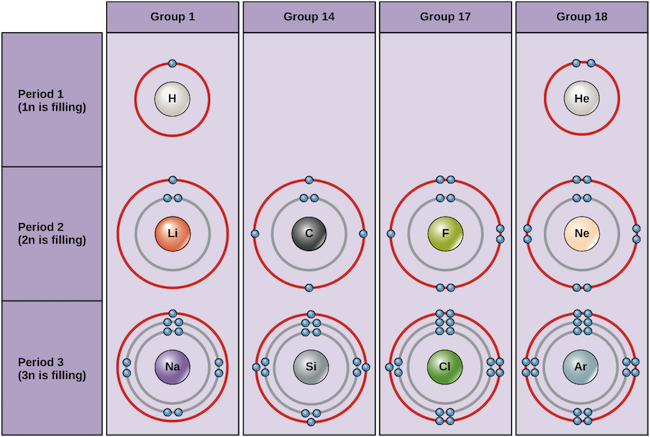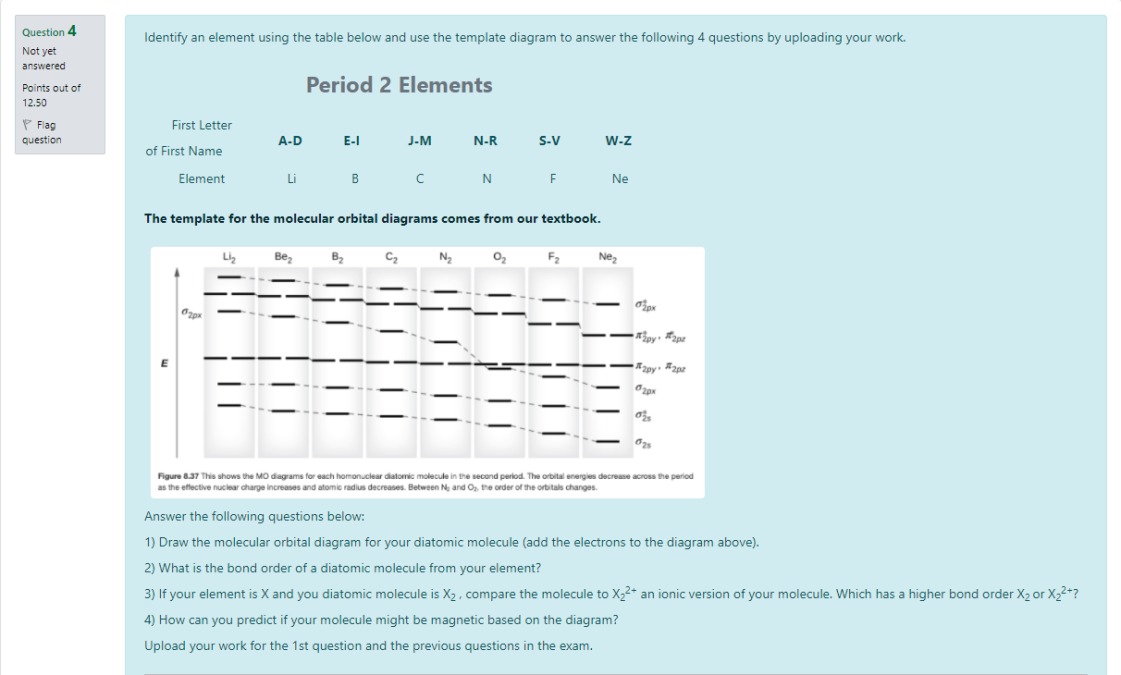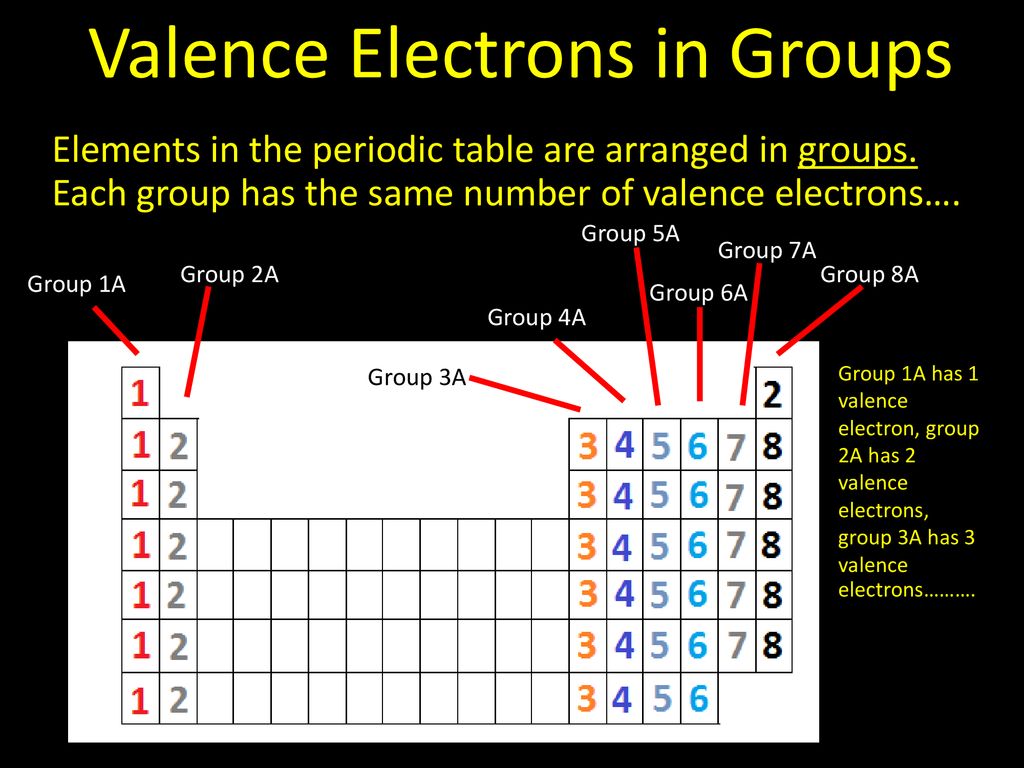1.
A. The number of valence electrons in aluminum is
1) 1e– 2) 2e– 3) 3e–
- Determine the number of valence electrons based on the group number. Once again, the group number of the element you are examining can tell you its valence electrons. However, for the transition metals, there isn't a pattern you can follow — group number will usually correspond to a range of possible numbers of valence electrons.
- Get the free 'Valence Shell Calculator' widget for your website, blog, Wordpress, Blogger, or iGoogle. Find more Chemistry widgets in Wolfram Alpha.
- The total number of electrons present in the valence shell of an atom are called valence electrons, and there are a total of two electrons present in the valence shell of calcium (4s²). Thus, calcium has two valence electrons.
The number of valence electrons in aluminum is. The change in electrons for octet requires a. 1) loss of 3e – C. The ionic charge of aluminum is. The symbol for the aluminum ion is. 1 What is the total number of valence electrons in a calcium atom in the ground state? (1) 8 (3) 18 (2) 2 (4) 20: 2: 2-8-8-2 the last number: 2 Which subatomic particles are located in the nucleus of an He-4 atom? (1) electrons and neutrons (2) electrons and protons (3) neutrons and protons (4) neutrons, protons, and electrons: 3.
B. The change in electrons for octet requires a
1) loss of 3e– 2) gain of 3e– 3) gain of 5e–
C. The ionic charge of aluminum is
1) 3– 2) 5– 3) 3+
D. The symbol for the aluminum ion is
1) Al3+ 2) Al3- 3) Al+
Show AnswerA. The number of valence electrons in aluminum is
3) 3e–
B. The change in electrons for octet requires a
1) loss of 3e–
C. The ionic charge of aluminum is
3) 3+
D. The symbol for the aluminum ion is
1) Al3+
2.
A. Number of valence electrons in sulfur is
1) 4e– 2) 6e– 3) 8e–
B. Change in electrons for octet requires a
1) loss of 2e– 2) gain of 2e– 3) gain of 4e–
C. Ionic charge of sulfur is
1) 2+ 2) 2- 3) 4-
Show AnswerA. Number of valence electrons in sulfur is
2) 6e–
B. Change in electrons for octet requires a
2) gain of 2e–
C. Ionic charge of sulfur is
2) 2-
3. Select the correct formula for each of the following ionic compounds
A. Na+ and S2-
1) NaS 2) Na2S 3) NaS2
B. Al3+ and Cl–
1) AlCl3 2) AlCl 3) Al3Cl
C. Mg2+ and N3-
1) MgN 2) Mg2N3 3) Mg3N2
Show AnswerA. Na+ and S2-
2) Na2S
check: 2Na+ + S2- = 2(1+) + 1(2-) = 0
B. Al3+ and Cl–
1) AlCl3
check: Al3+ + 3Cl– = (3+) + 3(1-) = 0
C. Mg2+ and N3-
3) Mg3N2
check: 3Mg2+ +2N3- = 3(2+) + 2(3-) = 0
4. Complete the names of the following ions:
Ba2+ Al3+ K+
_________ __________ _________
N3– O2– F–
_________ __________ _________
P3– S2– Cl–
_________ __________ __________
Show AnswerBa2+ Al3+ K+
barium aluminum potassium
N3– O2– F–
nitride oxide fluoride
P3– S2– Cl–
phosphide sulfide chloride
5. Write the names of the following compounds:
1) CaO ___________
2) KBr ___________
3) Al2O3 ___________
4) MgCl2 ___________
Show AnswerWrite the names of the following compounds:
1) CaO calcium oxide
2) KBr potassium bromide
3) Al2O3 aluminum oxide
4) MgCl2 magnesium chloride
6. Select the correct name for each.
A. Fe2S3
1) iron sulfide
2) iron(II) sulfide
3) iron (III) sulfide
B. CuO
1) copper oxide
2) copper(I) oxide
3) copper (II) oxide
Show AnswerSelect the correct name for each.
A. Fe2S3
3) iron (III) sulfide Fe3+ S2-
B. CuO
3) copper (II) oxide Cu2+ O2-
7. The correct formula for each of the following is:
A. Copper (I) nitride
1) CuN 2) CuN3 3) Cu3N
B. Lead (IV) oxide
1) PbO2 2) PbO 3) Pb2O4
Show AnswerThe correct formula is
A. Copper (I) nitride
3) Cu3N 3Cu+ + N3- = 3(1+) + (3-) = 0
B. Lead (IV) oxide
1) PbO2 Pb4+ + 2O2- = (4+) +2(2-) = 0
8. Match each formula with the correct name:
A. MgS 1) magnesium sulfite
MgSO3 2) magnesium sulfate
MgSO4 3) magnesium sulfide
B. Ca(ClO3)2 1) calcium chlorate
CaCl2 2) calcium chlorite
Ca(ClO2)2 3) calcium chloride
Show AnswerMatch each formula with the correct name:
A. MgS 3) magnesium sulfide

MgSO3 1) magnesium sulfite
MgSO4 2) magnesium sulfate
B. Ca(ClO3)2 1) calcium chlorate
CaCl2 3) calcium chloride
Ca(ClO2)2 2) calcium chlorite
9. Name each of the following compounds:
A. Mg(NO3)2
B. Cu(ClO3)2
C. PbO2
D. Fe2(SO4)3
E. Ba3(PO3)2
Show AnswerName each of the following compounds:
A. Mg(NO3)2 magnesium nitrate
B. Cu(ClO3)2 copper(II) chlorate
C. PbO2 lead (IV) oxide
D. Fe2(SO4)3 iron(III) sulfate
E. Ba3(PO3)2 barium phosphite
10. Write the correct formula for each:
A. potassium bromate
B. calcium carbonate
C. sodium phosphate
D. iron(III) oxide
E. iron (II) nitrite
Show AnswerWrite the correct formula for each:
A. potassium bromate KBrO3
B. calcium carbonate CaCO3
C. sodium phosphate Na3PO4
D. iron(III) oxide Fe2O3
E. iron (II) nitrite Fe(NO2)2
11. Name the following compounds:
A. Ca3(PO4)2
B. FeBr3
C. Al2S3
D. Zn(NO2)2
E. NaHCO3
Show AnswerName the following compounds:
A. Ca3(PO4)2 Ca2+ PO43− calcium phosphate
B. FeBr3 Fe3+ Br − iron(III) bromide
C. Al2S3 Al3+ S2− aluminum sulfide
D. Zn(NO2)2 Zn2+ NO2− zinc nitrite
Amount Of Valence Electrons In Calcium
E. NaHCO3 Na+ HCO3− sodium hydrogen carbonate
12. Write the formulas for the following:

A. calcium nitrate
B. iron(II) hydroxide
C. aluminum carbonate
D. copper(II) bromide
E. lithium phosphate
Show AnswerWrite the formulas for the following:
A. calcium nitrate Ca2+, NO3− Ca(NO3)2
B. iron(II) hydroxide Fe2+, OH− Fe(OH)2
C. aluminum carbonate Al3+, CO32− Al2(CO3) 3
D. copper(II) bromide Cu2+, Br− CuBr2
E. lithium phosphate Li+, PO43− Li3PO4
13. Match each formula with the correct name:
A. MgS 1) magnesium sulfite
MgSO3 2) magnesium sulfate
MgSO4 3) magnesium sulfide
B. Ca(ClO3)2 1) calcium chlorate
CaCl2 2) calcium chlorite
Ca(ClO2)2 3) calcium chloride
Show AnswerMatch each formula with the correct name:

A. MgS 3) magnesium sulfide
MgSO3 1) magnesium sulfite
MgSO4 2) magnesium sulfate
B. Ca(ClO3)2 1) calcium chlorate
CaCl2 3) calcium chloride
Ca(ClO2)2 2) calcium chlorite
14. Name each of the following compounds:
A. Mg(NO3)2
B. Cu(ClO3)2
C. PbO2
D. Fe2(SO4)3
E. Ba3(PO3)2
Show AnswerName each of the following compounds:
A. Mg(NO3)2 magnesium nitrate
B. Cu(ClO3)2 copper(II) chlorate
C. PbO2 lead (IV) oxide
D. Fe2(SO4)3 iron(III) sulfate
E. Ba3(PO3)2 barium phosphite
15. Select the correct formula for each:
A. aluminum nitrate
1) AlNO3 2) Al(NO)3 3) Al(NO3)3
B. copper(II) nitrate
1) CuNO3 2) Cu(NO3)2 3) Cu2(NO3)
C. iron (III) hydroxide
1) FeOH 2) FeOH3 3) Fe(OH)3
D. tin(IV) hydroxide
1) Sn(OH)4 2) Sn(OH)2 3) Sn4(OH)
Show AnswerSelect the correct formula for each:
A. aluminum nitrate
3) Al(NO3)3
B. copper(II) nitrate
2) Cu(NO3)2
C. iron(III) hydroxide
3) Fe(OH)3
D. tin(IV) hydroxide
1) Sn(OH)4
16. Write the correct formula for each:
A. potassium bromate
B. calcium carbonate

C. sodium phosphate
D. iron(III) oxide
E. iron (II) nitrite
Show AnswerWrite the correct formula for each:
A. potassium bromate KBrO3
B. calcium carbonate CaCO3
C. sodium phosphate Na3PO4
D. iron(III) oxide Fe2O3
E. iron (II) nitrite Fe(NO2)2
17. Name the following compounds:
A. Ca3(PO4)2
B. FeBr3
C. Al2S3
D. Zn(NO2)2
E. NaHCO3
Show AnswerName the following compounds:

A. Ca3(PO4)2 Ca2+ PO43− calcium phosphate
B. FeBr3 Fe3+ Br − iron(III) bromide
C. Al2S3 Al3+ S2− aluminum sulfide
D. Zn(NO2)2 Zn2+ NO2− zinc nitrite
E. NaHCO3 Na+ HCO3− sodium hydrogen
18. Write the formulas for the following:
A. calcium nitrate
B. iron(II) hydroxide
C. aluminum carbonate
D. copper(II) bromide
E. lithium phosphate
Show AnswerWrite the formulas for the following:
A. calcium nitrate Ca2+, NO3− Ca(NO3)2
B. iron(II) hydroxide Fe2+, OH− Fe(OH)2
C. aluminum carbonate Al3+, CO32− Al2(CO3) 3
D. copper(II) bromide Cu2+, Br− CuBr2
E. lithium phosphate Li+, PO43− Li3PO4
The electrons of an atom are typically divided into two categories: valence and core electrons. Valence electrons occupy the outermost shell or highest energy level of an atom while core electrons are those occupying the innermost shell or lowest energy levels. This difference greatly influences the role of the two types of electrons in a chemical reaction. Generally, valence electrons can participate in the formation of chemical bonding, but core electrons cannot. While core electrons are not involved in bonding, they influence the chemical reactivity of an atom.
The electron configuration of a oxygen atom is
[ce{O}: ,1s^22s^22p^4 label{1}]
which may be shorted
[ce{O}:, [He]2s^2 2p^4 label{2}]
where the ([He]) stands for the configuration of helium ((1s^2)). Similarly, the configuration of calcium with 20 electrons can be written
[ce{Ca}:, [Ar]4s^2 label{3}]
where the ([Ar]) stands for the configuration of argon ((1s^22s^22p^6 3s^2 3p^6)). Electronic configurations that are the same as noble gases are very stable since they have a full octet (except helium with a full 1s orbital).
The (1s) electrons in oxygen do not participate in bonding (i.e., chemistry) and are called core electrons. The valence electrons (i.e., the (2s^22p^4) part) are valence electrons, which do participate in the making and breaking of bonds. Similarly, in calcium (Equation (ref{3})), the electrons in the argon-like closed shell are the core electrons and the the two electrons in the 4s orbital are valence electrons.
Example (PageIndex{1}): Cobalt
What are the core and valence electrons in cobalt?
Solution
Start by writing the electron configuration of cobalt with 27 electrons:
[1s^22s^22p^63s^23p^64s^23d^7 nonumber]
However, argon has the electronic structure (1s^22s^22p^23s^23p^6), so we can rewrite the configuration as
[[Ar]4s^23d^7 nonumber]
The two electrons in the (4s) orbital and the seven electrons in the (3d) are the valence electrons: all others are core electrons.
The periodicity of valance electrons can be seen in the Periodic Table. Basically, the periodicity is only applied to the main group elements, while in transition metals, rules are complex.
The core electrons remain the same in the increase of group numbers in the main group elements. On the other hand, the valance electrons increase by one from left to right of a main period, and remain the same down the column of a main group. This evolution gives periodical change in property of a period, and similar chemical property of a group, which is called periodical trend. The number of valence electrons in a main period is the same as its group number. The table below shows this rule clearly.
Under construction
Number Of Valence Electrons In Calcium Ion
Figure 1: 1A + 2A are metals. 3A to 8A are non-metals.
However, this periodicity cannot be applied to the transition group, which is more complicated than that of the main group. Although the outermost electrons can be easily determined, the apparent valence electrons considered in chemical reactivity are complex and fluctuated. Electrons going into d sublevel can play either a role of valence electrons or shielding electrons. So there is not always a certain number of apparent valence electrons. The number of apparent valence electrons for the first transition metal period is shown in the table below.
Under construction
Figure 2: Valence electrons for transition metals.
Relationship with Chemical Reactivity
Total Number Of Valence Electrons In Calcium Carbide
The chemical reactivity of an atom is mainly determined by valence electrons. Atoms which have a complete shell of valence electrons tend to be chemically inert. Atoms with one or two valence electrons are highly reactive. This phenomenon can be explained by Hund's rule, which states that orbitals that are empty, half-full, or full are more stable than those that are not. For example, Ne is chemically inert because it has two valence electrons that fill its outermost shell which makes it stable compared to atoms such as Al, which has three valence electrons, but its valence electrons does not fill its outermost shell.
Although core electrons do not take part in chemical bonding, they play a role in determining the chemical reactivity of an atom. This influence is generally due to the effect it has on valence electrons. The effect can be observed from the gradual change of chemical reactivity in a group. As you go down a group, more shells are occupied by electrons, which increases the size of the atom. The more core electron shells an atom has, the larger the size of the atom, and the farther the valence electrons are from the nucleus, thus the valence electrons will experience less effective nuclear charge and will be easily lost. For example, (ce{Na}) and (ce{K}) can both react with water, but K has a more radical reaction because it has more shells of core electrons which makes the valence electron in its outermost orbital much easier to lose than the valence electron of Na.
References
List Of Valence Electrons For Each Element
- Miessler, Gary L., and Donald A. Tarr. Inorganic Chemistry. Upper Saddle River, NJ: Pearson Prentice Hall, 2010. Print.
- Brown, Ian David. The Chemical Bond in Inorganic Chemistry the Bond Valence Model. Oxford: Oxford UP, 2006. Print.
